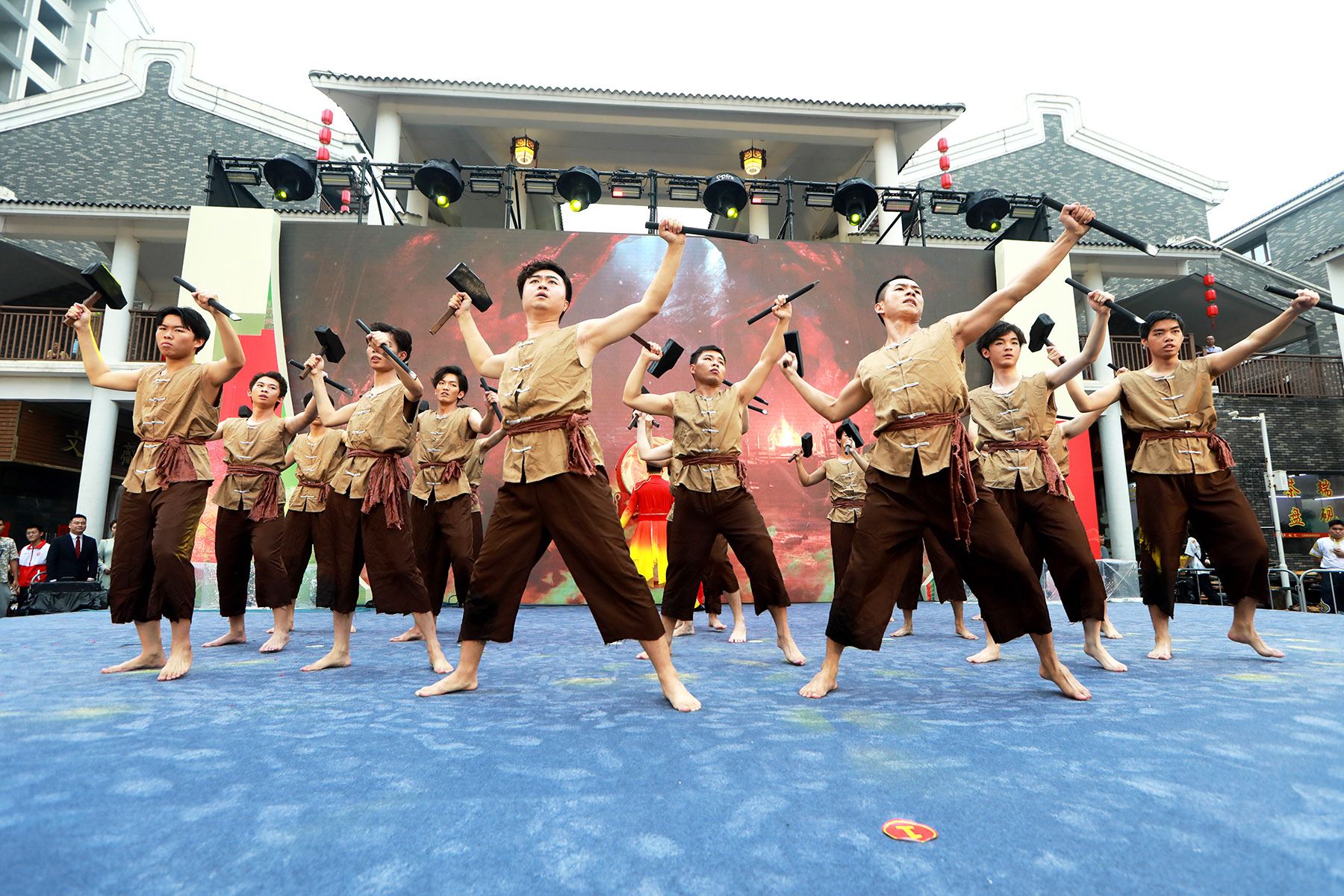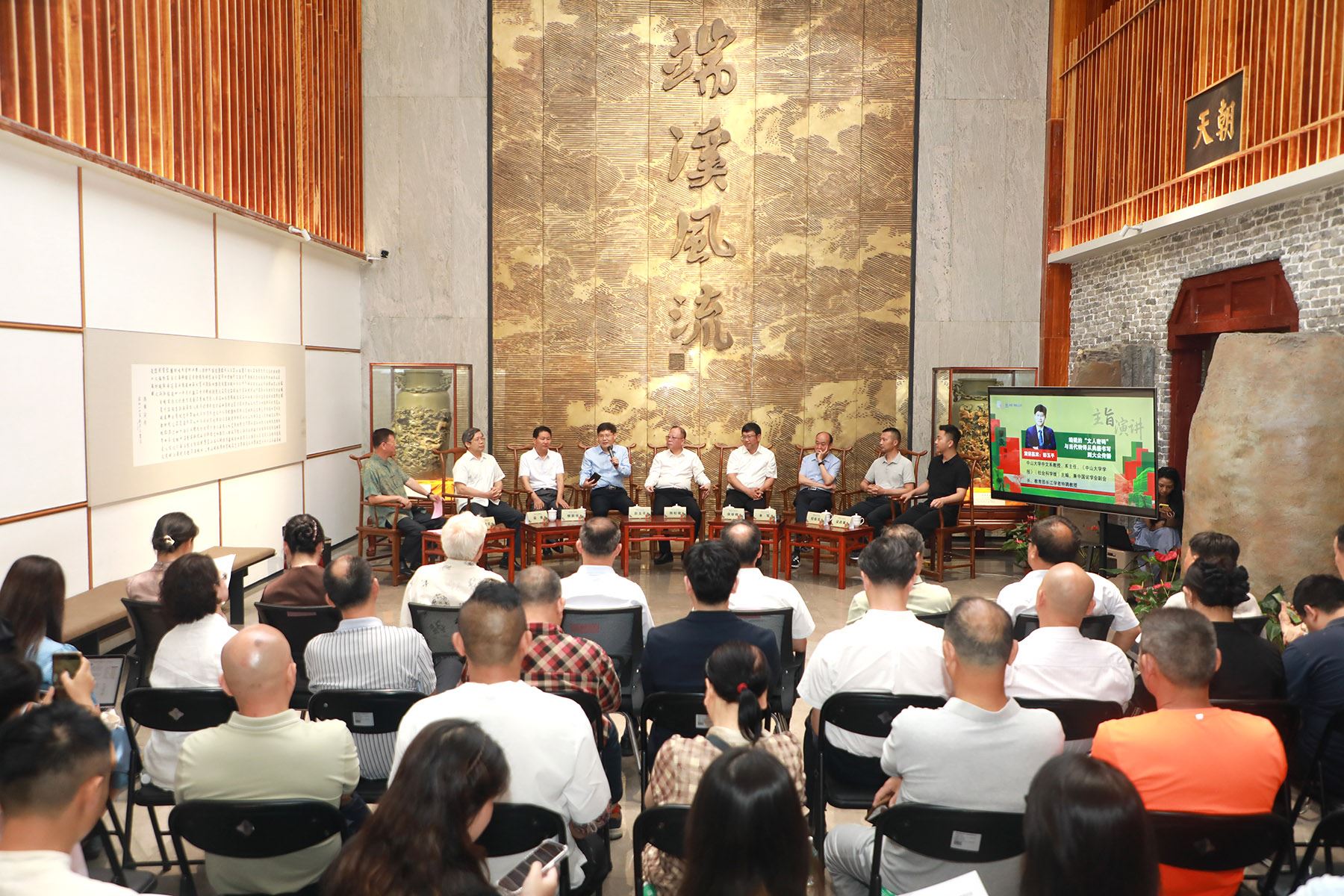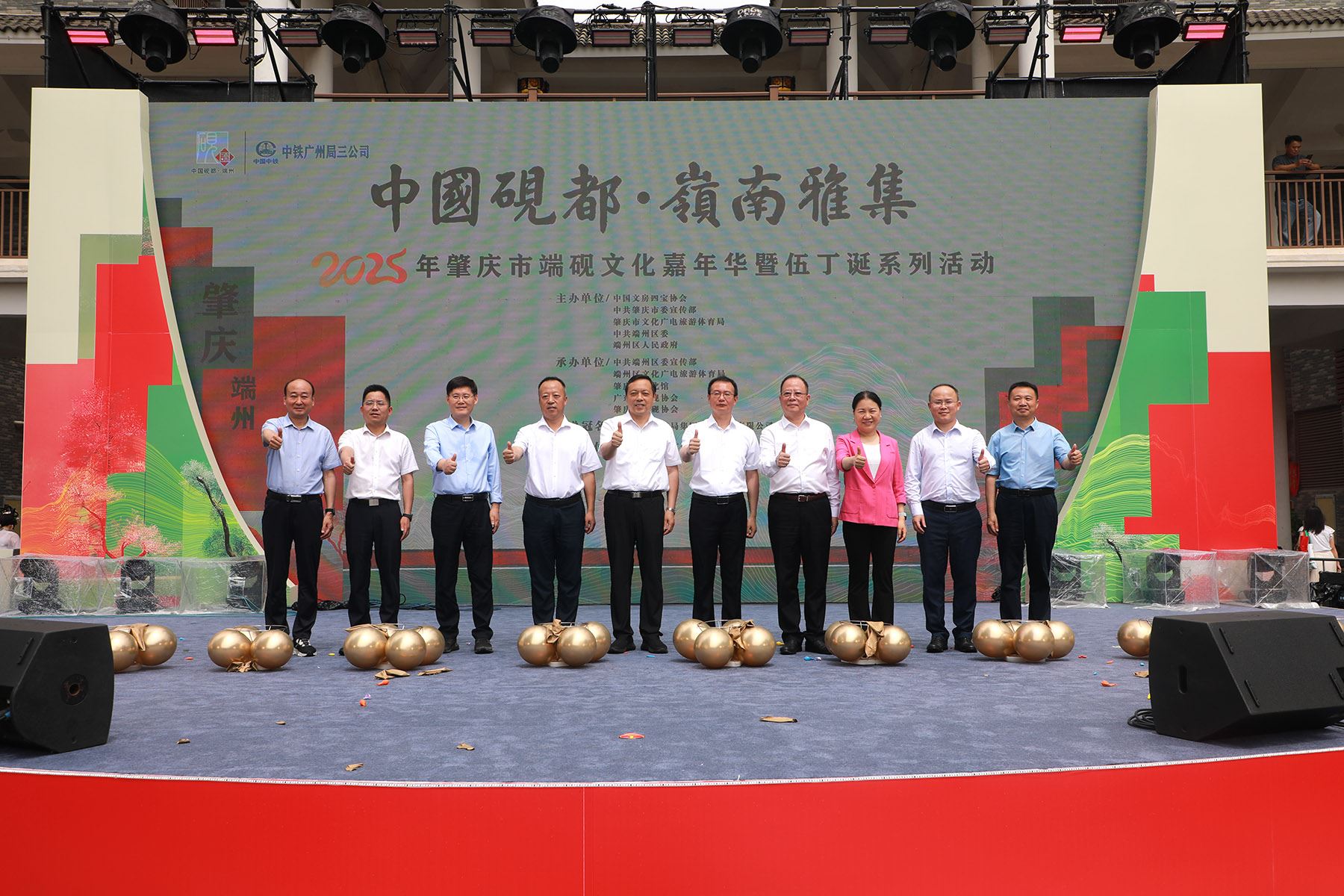The Greater Bay Area is going all out to make itself a cultural magnet for an evolving breed of travelers who are not satisfied with unrivaled sights, bustling nightlife or pristine beaches. As Zhou Mo reports, the goal is to make the region a unified tourism brand.

Baishi and Binri villages in Zhaoqing city, Guangdong province, were bathed in festivity on May 5 — the eighth day of the fourth month in the lunar calendar — as a grand feast got underway.
The thunderous beating of gongs and drums filled the air amid dragon and lion dances in perfect sync. Surrounded by flag-bearers elegantly waving red flags, four men carried the statue of Wu Ding — a legendary figure regarded as the founding ancestor of stone carving in the Duan inkstone industry — to the heart of the celebrations.
Duan inkstone-carving masters who inherited the craftsmanship, and cultural researchers took center stage, bowing before the statue to pay their respects.
ALSO READ: Inkstone artisanship sees cultural revival
Their apprentices served them tea as a gesture of respect and commitment to their studies. The annual Wu Ding Festival — an intangible cultural heritage of Guangdong — has been passed down for generations, with Zhaoqing making every effort to promote the tradition and cultural tourism.
Combining tourism and local culture is a sign of the times, reflecting the province’s relentless efforts to take the travel business to greater heights. Travelers aren’t content with a superficial visit to a city to take in the sights, but are delving into deeper links, wanting to experience a place’s culture and the daily lives of its people.
The Guangdong authorities introduced measures this year to improve the quality of tourism and accelerate the construction of a strong tourism venue through deeper integration of culture and travel.

Arts and historical resources are to be integrated with tourism by building culturally rich, Lingnan-style resorts. Guangdong will also launch cultural tourism routes featuring relics, revolutionary history and traditional Chinese customs.
Integrated development of multiple industries, including “performance-plus-tourism”, “food-plus-tourism” and “competition-plus-tourism” initiatives will be encouraged.
“We don’t want a trip that merely concerns a place’s attractions. We want to understand a city, its customs and taste local cuisine. That’s the true meaning of travel,” says Shenzhen resident Wu Zijuan.
She took her family to Zhongshan for three days during this year’s Labor Day holidays. “We didn’t spend much time at tourist attractions. Instead, we took in dragon boat races, music festivals and local delicacies.”
New trends
According to preliminary official data, Guangdong raked in nearly 30 billion yuan ($4.16 billion) in tourism revenue during the five-day holiday break — up 20.3 percent year-on-year.
READ MORE: Cultural power fuels rise of GBA
Tourist arrivals climbed 18.7 percent on a yearly basis to 46.1 million. Hong Kong welcomed 1.1 million travelers during the same period — a 22-percent increase from a year ago — while Macao saw tourist arrivals surge 41 percent to 850,000.
Dai Bin, president of the China Tourism Academy, says integrating culture and tourism is the trend. “More and more tourists go to destinations not just for the scenery.
They want to join in cultural and artistic activities,” he says. “Places with a taste of local life, cultural richness and technological appeal captivate visitors, bringing greater satisfaction.”
Besides Zhaoqing, other Chinese mainland cities in the Guangdong-Hong Kong-Macao Greater Bay Area did likewise during the Labor Day break to lure visitors.

Zhongshan organized 50 events featuring intangible cultural heritage, such as drunken dragon dances, embroidery and herbal tea with local characteristics.
Huizhou offered an immersive drama at Dongpo Temple — the former residence of famous Chinese poet Su Dongpo, also known as Su Shi, from the Song Dynasty (960-1279) — drawing 32,000 viewings in three days, with visitor numbers up 50 percent year-on-year.
Tourism industry players in Guangdong are shifting their approach to cater to the new dynamics. The makeup of tourists and their preferences have undergone significant changes in the past few years, notes Shi Hui, marketing director of Window of the World — a popular Shenzhen theme park featuring miniatures of prominent landscapes around the globe.
READ MORE: ‘Debut economy’ of cultural industry to drive consumption
“Young people aged 18 to 30 are becoming the fastest-growing group of consumers. They like immersive experience and social networking,” she says. “Previously, tourists were only interested in sightseeing, but now they want to get more involved, and like to share with others what they see. This has led us to transform our business as traditional products alone don’t satisfy them.”
Window of the World is enhancing an immersive cultural experience for visitors, focusing on intellectual property creation on festive occasions. “We have been holding themed cultural events each year, including an International Street Art Festival, an International Beer Festival and a Pop Music Carnival. We want to combine them with modern interpretations of Chinese culture to form our IPs,” says Shi, noting that the park is being transformed from a “landscape exhibitor” into a “cultural experience operator”.

Shenzhen-based cultural and tourism giant OCT Group, which owns Window of the World, is trying to combine cultural tourism with other sectors, such as commerce, real estate and the creative industry, to ensure a bigger slice of the cake.
The company sees Guangdong as its chief battleground that boasts a favorable political and business environment, a solid market foundation and advantageous geographical conditions, OCT Group told China Daily, saying it will continue to innovate and explore new ways of promoting culture and tourism.
Guan Jian, director of communications at Guangzhou-based GZL International Travel Service, says the agency will add cultural elements to its tourism products. “Among our domestic travel routes, over 80 percent have cultural elements.
The proportion has been growing in the past few years, and products with a cultural appeal have been enthusiastically received by customers.”
Striking a balance
While tourism serves as a powerful means of promoting cultural exchanges and development, and allowing people to experience diverse traditions and lifestyles, there is a danger of cultural degradation.
READ MORE: Foreign entrepreneurs praise China's soft power, call for greater openness
When tourist destinations become overly commercialized, cultural practices may be diluted or altered to cater to tourist expectations. “Developing some cultural and historical areas has given rise to problems like homogeneity and lack of diversity in business, while others are blamed for over-commercialization.
Thus, residents might feel that local culture is weakened, and their sense of belonging is undermined. This would lead to resistance or even hostility to tourism development,” warns Mao Zidan, associate professor at the School of Tourism Management at Sun Yat-sen University in Guangzhou.
The development of historical and cultural areas in urban villages or overseas Chinese communities, which are common in Guangdong, also involves complex issues concerning property rights, population and people’s diverse needs, explains Mao. “Take Shenzhen’s Nantou Ancient Town, for example. The historical site has been turned into a place where migrants have gathered and lived throughout its 1,700-year history.
In developing cultural tourism here, we need to better handle relations among stakeholders, such as the government, enterprises, villagers and migrants.” In Mao’s view, local governments should take the initiative in creating a favorable environment for tourism by building a platform for dialogue among industry players, while protecting public interests.

Collaborative strategies
However, she has a positive outlook for cultural tourism development in the Greater Bay Area, suggesting that Hong Kong, Macao and the nine Guangdong cities leverage their complementary strengths to create synergy and make the region a unified tourism brand.
Guan says he believes it’s essential to develop tourism in the region as a whole, noting that, compared with other popular tourist destinations in the country, such as Beijing, Shanghai, Chengdu and Xi’an, cities in the Greater Bay Area are better known internationally for commerce.
“When people talk about Guangzhou or Shenzhen, the first thing that comes to their mind is business. How can we promote tourism in these cities? Instead of developing the industry on their own, cities in the Greater Bay Area should work together to integrate their resources and build the Greater Bay Area into a tourism brand so that the region’s attractiveness and competitiveness, as a whole, can be strengthened,” Guan suggests.
Guangdong’s Department of Culture and Tourism — formerly the Tourism Administration of Guangdong province — the Hong Kong Tourism Board, and the Macao Government Tourism Office jointly set up the Guangdong-Hong Kong-Macao Tourism Marketing Organization in 1993 to boost communication, share resources and foster joint development.
READ MORE: China's tourism market sees surge during Labor Day holiday
The organization has been implementing a rotating chairmanship system since 2008, with Guangdong acting as chair this year. At their 85th work meeting in Guangzhou in March, tourism officials from the three cities agreed to roll out joint promotion projects this year, such as promotional campaigns in Europe, promoting multidestination tourism products overseas through online platforms, and inviting international industry players to visit the Greater Bay Area.
A joint overseas promotion campaign was held in Jakarta, Indonesia, last year, launching various initiatives to enable travelers from the Southeast Asian nation to learn more about the Greater Bay Area’s tourism resources, and increase their interest in visiting the region.
Discounts were offered to Indonesian tourists booking flight tickets, hotels and tourist activities through certain travel agencies. Celebrities who are popular among younger people were invited to visit Hong Kong, Macao, Guangzhou and Shenzhen, with programs to introduce the region’s cultural and historical sites.
“Developing multidestination tourism products in the Greater Bay Area is among our priorities. The updating rate of our multidestination tourism products could reach 30 to 40 percent annually in the past few years,” says Guan.
According to a report published by Sun Yat-sen University and the Chinese University of Hong Kong last year, Hong Kong, Guangzhou and Macao, with abundant leisure resources and developed infrastructures, were the top three choices of tourists among cities in the Greater Bay Area.
Guangzhou, Shenzhen and Fo-shan led in the quality of services, while Zhaoqing, Jiangmen and Huizhou were seen as more affordable cities as their level of consumption was relatively low.
Contact the writer at sally@chinadailyhk.com


